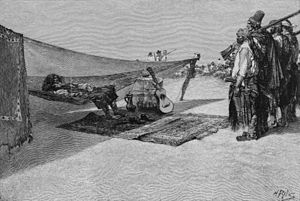Brethren of the Coast

The Brethren or Brethren of the Coast were a loose coalition of pirates and buccaneers that were active in the seventeenth and eighteenth centuries in the Atlantic Ocean, Caribbean Sea, and Gulf of Mexico. They mostly operated in two locations, the island of Tortuga off the coast of Haiti and in the city of Port Royal on the island of Jamaica. [1]
They were a syndicate of captains with letters of marque and reprisal who regulated their privateering enterprises within the community of privateers and with their outside benefactors. They were primarily private individual merchant mariners of Protestant background, usually of English and French origin.[2]
History
They were originally refugees that settled in Hispaniola,[2][3] mostly French Huguenot and British Protestants.[4] They would supply wares to visiting ships in exchange for guns and ammunition.[2] This activity lead to the Spanish driving them out. These former refugees would live in something akin to a republic.[5] Despite their origins their ranks would swell as they were joined by other adventurers of various nationalities including Spaniards, African sailors, as well as escaped slaves, and outlaws of various sovereigns.[1]
The English had their hay-day around the 1650's, when they seized Tortuga from the spanish. These privateers were issued letters of marque to defend the island from the Spanish [2] and raid Catholic French and Spanish shipping.[6]
Their decline can be attributed to various factors. The peace between William of Orange and Spain[5] caused a decrease in the need for privateering. The Treaty of Madrid (1670) resulted in the English renouncing their claims to Caribbean territories. [7][8] In addition to that the demographic changes which featured the rise of slave labor in the Caribbean islands was a compounding factor.[9] Most maritime families moved to the mainland colonies of the future United States or to their home countries.[9] A few, unable to compete effectively with slave labor, enamored of easy riches, or out of angst, continued to maintain the Brethren of the Coasts as a purely criminal organization which preyed upon all civilian maritime shipping. This second era of the Brethren began the age of piracy and brigandage which affected the Caribbean until socioeconomic and military changes of the late 18th and early 19th century finally broke its back. Many pirates made their journeys there, and one of the most famous was Alexandre Exquemelin.
Code of Conduct
In keeping with their Protestant and mostly common law heritage, the Brethren were governed by codes of conduct that favored legislative decision-making, hierarchical command authority, individual rights, and equitable division of revenues. Henry Morgan, one of the most well known Brethren, is usually credited with codifying its organization.[5]
In Media
A fictionalized, romanticized version of the Brethren was featured in the Pirates of the Caribbean films.
See also
Notes
References
- Kemp, Peter C. L. (1961). Brethren of the Coast: The British and French Buccaneers of the South Sea. Florida: Krieger Publishing Company.
- Marx, Jennifer (1991). Pirates and Privateers of the Caribbean. New York: St. Martin's Press.
- Thomson, Janice E. (1969). Mercenaries, Pirates and Sovereigns. New York: Reinehart and Winston. ISBN 9780691086583.

